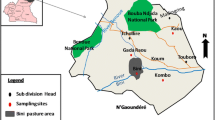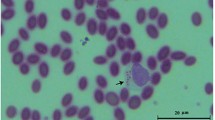Abstract
The study was conducted to characterize the morphological features of Mursi cattle breed and to identify the species of trypanosome infecting the cattle and its prevalence in these traditionally managed cattle in the Bodi and Mursi pastoral communities. Cattle body description and measurements were made on 201 matured animals. Blood samples were collected from 409 animals into heparin-treated capillary tubes and were centrifuged to 12,000 rpm for 5 min to identify trypanosome species from the wet smeared buffy coat and to estimate the degree of anemia (PCV). Tsetse flies were collected using phenol-treated biconical trap and the caught flies identified to species level. The breed possesses variable coat color pattern, coat color type, and have small to medium hump size on the thoracic vertebrae. Body measurement of Mursi cattle in the two locations did not show significant differences except chest girth, rump width, and horn length. Trypanosome prevalence in the Mursi cattle breed was 6.1 %. The highest trypanosome infection was caused by Trypanosoma congolense (56 %) followed by Trypanosoma vivax (40 %) and Trypanosoma brucei (4 %). Trypanosome prevalence significantly varies between dry (2.0 %) and late rainy (10.1 %) seasons (P < 0.001) and between lean (11.9 %) and medium (2.4 %) body condition score (P < 0.01). The PCV value was 22.1 ± 0.5 %, which is significantly varied with season (P < 0.01) and parasitism (P < 0.001). Parasitaemic cattle show the lowest PCV value (20.4 ± 1%) than aparasitaemic (23.7 ± 0.3 %) cattle and cattle with lean BCS showed the lowest (P < 0.0001) PCV value (20.4 ± 0.6 %). Tsetse fly species identified in the study area were Glossina pallidipes, Glossina morsitans submorsitans, and Glossina fuscipes. The number of flies captured in late rainy season was higher than in dry season (P < 0.01). Despite the existence of trypanosome and high tsetse fly infestation in the areas, large proportion of the Mursi cattle shows medium BCS, low trypanosome prevalence, and higher PCV value.

Similar content being viewed by others
References
Agyemang, K. (ed.), 2005. Trypanotolerant livestock in the context of trypanosomiasis intervention strategies. Programme Against African Trypanosomiasis (PAAT) Technical and Scientific Series 7. Food and Agriculture Organization of the United Nations, Rome. 66pp.
Ayalew, W., 2001. Revised filed Report on survey of a sample of the Sheko cattle maintained at the former Tolley Military Training Center, http://dagris.ilri.cgiar.org. Accessed January 25, 2013
Ayalew, W. and Rowlands, J. (eds)., 2004. Design, execution and analysis of the livestock breed survey in Oromiya Regional State, Ethiopia. OADB (Oromiya Agricultural Development Bureau), Addis Ababa, Ethiopia, and ILRI (International Livestock Research Institute), Nairobi, Kenya. 260 pp
Ayele, T., Ephrem, D., Elias, K., Tamiru, B., Gizaw, D., Mebrahtu, G. and Mebrat, E., 2012. Prevalence of Bovine Trypanosomosis and its Vector Density in Daramallo District, South Western Ethiopia. Journal of Veterinary Advances, 2(6):266–272
Barry, J.D. and McCulloch, R., 2001. Antigenic variation in trypanosomes: enhanced phenotypic variation in a eukaryotic parasite. Advanced Parasitology 49: 1–70
Baumgärtner, J., Gilioli, G. Getachew Tikubet and Gutierrez, A.P., 2008. Eco-social analysis of an East African agro-pastoralsystem: Management of tsetse and bovine trypanosomiasis Ecological Economics. 65(1):125–135
Chaka, H. and Abebe, G., 2003. Drug Resistant Trypanosomes: a Threat to Cattle Production in the Southwest of Ethiopia. Revue d’élevage et de Médecine vétéronaire des pays tropicaux, 56 (1–2): 33–36
Dagnachew, S., Sangwan, A.K. and Abebe, G., 2005. Epidemiology of Bovine Trypanosomosis in the Abay (Blue Nile) Basin Areas of Northwest Ethiopia. Revue d’élevage et de Médecine vétéronaire des pays tropicaux, 58(3): 151–157
Dagnachew, S. Girma, H. and Abebe, G., 2011. A cross-sectional study on bovine trypanosomosis in Jawi district of Amhara Region, Northwest Ethiopia. The Veterinary Journal, 15 (1), 69–78
FAO, 1982. Training Manual for Tsetse Control Personnel. Vol. 1.Tsetse biology, systematic and distribution techniques. N. Pollock (ed.). Food and Agriculture Organization of the United Nations (FAO), Rome
FAO, 2012. Phenotypic characterization of animal genetic resources. FAO (Food and Agriculture Organization of the United Nations) Animal Production and Health Guidelines No. 11. Rome.
Haas, Y.D., Janss, L.L.G. and Kadarmideen, H.N., 2007. Genetic correlations between body condition scores and fertility in dairy cattle using bivariate random regression models. Journal of Animal Breeding and Genetics, 124: 277–285
IGAD LPI, 2010. The Contribution of Livestock to the Ethiopian Economy – Part II. IGAD LPI (Intergovernmental Authority on Development Livestock Policy Initiative). Working Paper No. 02 – 11. pp43.
Leak, S.G.A., Woume, K.A., Colardeue, C., Duffera, W., Feron, A., Mulingo, M., Tikubet, G., Toure M. and Yangari, G., 1987. Determination of tsetse challenge and its relationship with trypanosomosis prevalence. In: livestock production in tsetse infested areas of Africa. Nairobi, Kenya, ATLN, pp. 43–52.
Lemecha, H., Woudyalew, M., Hussein, I., Rege, J.E.O., Tekle, T., Abdicho, S. and Ayalew, W., 2006. Response of four indigenous cattle breeds to natural tsetse and trypanosomosis challenge in the Ghibe valley of Ethiopia. Veterinary Parasitology 141 (1–2):165–176
Murray, M., Trail, J.C.M., Turner D.A. and Wissocq, Y., 1983. Livestock Productivity and Trypanotolerance. Network Training Manual, International Livestock Centre for Africa, Addis Ababa, Ethiopia, 4–10
Naessens, J., 2006. Bovine trypanotolerance: A natural ability to prevent severe anaemia and haemophagocytic syndrome. International Journal for Parasitology, 36: 521–528
Nicholson, M.J. and Butterworth, M.H., 1986. A Guide to Condition Scoring of Zebu Cattle. International Livestock Centre for Africa (ILCA). Addis Ababa, Ethiopia. 29pp
Olson, T.A., Lucena, C., Chase C.C. and Hammond, A.C., 2003. Evidence of a major gene influencing hair length and heat tolerance in Bos taurus cattle. Journal of Animal Science, 81:80–90
Ouma, E., Abdulai, A. and Drucker, A., 2005. Assessment of Farmer Preferences for Cattle Traits in Cattle Production Systems of Kenya. Paper prepared at the 11th Congress of the EAAE (European Association of Agricultural Economists). August 24–27, 2005, Copenhagen, Denmark. http://ageconsearch.umn.edu/bitstream/24730/1/cp05ou02.pdf. Accessed July 22, 2010
Pathak, A.K., 2009. Effect of Trypanosome species on Nutritional status and performance of livestock. Veterinary World, 2(11):435–438
Rege, J.E.O. 1999. The state of African cattle genetic resources I. Classification framework and identification of threatened and extinct breeds. Animal Genetic Resources Information Bulletin, 25: 1–25
Rege, J.E.O. and Tawah, C.L., 1999. The state of African cattle genetic resources II. Geographical distribution, characteristics and uses of present-day breeds and strains. Animal Genetic Resources Information Bulletin, 26:1–25
SAS (Statistical Analysis System), 2002. SAS for windows, Release 9.0. SAS Institute, Inc.,Cary, NC, USA
Stein, J, Ayalew, W., Rege, E., Mulatu, W., Lemecha, H. Tadesse, Y., Tekle, T. and Philipsson, J., 2011. Trypanosomosis and phenotypic features of four indigenous cattle breeds in an Ethiopian field study. Veterinary Parasitology, 178(1–2):40–47
Terefe, E., Dessie, T., Haile, A., Mulatu, W. and Mwai, O., 2012. Husbandry and breeding practices of cattle in Mursi and Bodi pastoral communities in Southwest Ethiopia. African Journal of Agricultural Research, 7(45), 5986–5994.
Tesfaye, T., 2008. Range-Livestock Management Practices and Condition Assessment of the Rangelands in Mursi-Bodi (Salamago) District of the SNNPR, Ethiopia, (Unpublished MSc thesis, Hawassa University)
Zeryehun, T. and Abraham, Z., 2012. Prevalence of Bovine Trypanosomosis in Selected District of Arba Minch, SNNPR, Southern Ethiopia. Global Veterinaria 8(2): 168–173
Bishaw, Y., Temesgen, W., Yideg, N. and Alemu, S., 2012. Prevalence of bovine trypanosomosis in Wemberma district of West Gojjam zone, North West Ethiopia. Ethiopian Veterinary Journal 16(2): 41–48
Acknowledgments
The authors would like to acknowledge ILRI for funding the project and providing facilities for this study. We also acknowledge the South Omo zone and Salamago Wereda Administration and Agriculture office and Kebele agricultural development agents and South-Ethiopia Tsetse fly Eradication Program (STEP) administration and technical staffs.
Conflict of interest
The authors declare that they have no conflict of interest.
Author information
Authors and Affiliations
Corresponding author
Rights and permissions
About this article
Cite this article
Terefe, E., Haile, A., Mulatu, W. et al. Phenotypic characteristics and trypanosome prevalence of Mursi cattle breed in the Bodi and Mursi districts of South Omo Zone, southwest Ethiopia. Trop Anim Health Prod 47, 485–493 (2015). https://doi.org/10.1007/s11250-014-0746-7
Received:
Accepted:
Published:
Issue Date:
DOI: https://doi.org/10.1007/s11250-014-0746-7




